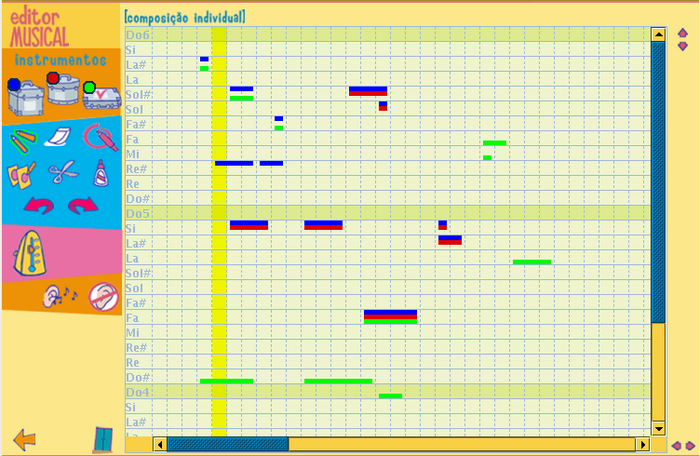Musical Editor: Difference between revisions
Jump to navigation
Jump to search
Oswaldopoli (talk | contribs) |
(form) |
||
| (2 intermediate revisions by 2 users not shown) | |||
| Line 13: | Line 13: | ||
Download here: http://code.google.com/p/editor-musical/downloads/list |
Download here: http://code.google.com/p/editor-musical/downloads/list |
||
After unpacking the file, go to "MusicalEditor.activity" directory and read README to |
After unpacking the file, go to "MusicalEditor.activity" directory and read the README to learn how to proceed. |
||
== The Application == |
== The Application == |
||
| Line 47: | Line 47: | ||
* Bruno Fialho Marques Gola |
* Bruno Fialho Marques Gola |
||
* Gustavo Rocha Dias |
* Gustavo Rocha Dias |
||
* Joyce Alessandra Saul |
* [[user:Joyce|Joyce Alessandra Saul]] |
||
* Irene Karaguilla Ficheman |
* Irene Karaguilla Ficheman |
||
* Oswaldo Bassani Neto |
* Oswaldo Bassani Neto |
||
| Line 66: | Line 66: | ||
[[Category:Software ideas]] |
[[Category:Software ideas]] |
||
[[Category:Music]] |
[[Category:Music]] |
||
{{Activity page |
|||
|icon=Image:Activity-musical.png |
|||
|genre=Media, Audio, and Video Players |
|||
|short description=The Musical Editor is a musical software that allows children to learn how to develop their own compositions. |
|||
|contact person=NATE-LSI |
|||
|activity source=http://code.google.com/p/editor-musical/downloads/list |
|||
}} |
|||
Latest revision as of 23:10, 7 August 2008
| Musical Editor | |
| Status: | Demonstration |
| Version: | 1.3 |
| Base: | unknow |
| Source: | unknow |
| l10n: | missing |
| Contributors | |
| NATE-LSI | |
Download Demo Version
Download here: http://code.google.com/p/editor-musical/downloads/list
After unpacking the file, go to "MusicalEditor.activity" directory and read the README to learn how to proceed.
The Application
The Musical Editor is a musical software that allows children to learn how to develop their own compositions.
It has been developed by LSI (Integrated Systems Laboratory)
LSI is a Brazilian institution that has developed applications to support Education and has created some teams to work on OLPC software development.
These teams are rewriting some Java applications in Python.
One of these applications is the Musical Editor.
Features
- Easy to use
- No limitation on quantity of instruments
- Currently, the composition mode is unique (Grid Mode), however it's probable that new modes integrate the software
- Each instrument belongs to a group (for example, the group of string instruments), each group has a specific color.
Thus, the user can associate the color to the group of the instrument and will notice that each group has a role in music.
- The application runs in mono-user or collaborative mode (using the mesh network)
- We will try to implement a way of recording sounds from the internal microphone of OLPC
Team
- Alexandre Martinazzo
- Bruno Fialho Marques Gola
- Gustavo Rocha Dias
- Joyce Alessandra Saul
- Irene Karaguilla Ficheman
- Oswaldo Bassani Neto
- Rafael Barbolo Lopes
- Roseli de Deus Lopes
Related Links
- Editor Musical -- Portuguese version of this page
Activity Summary
| Icon: | Sugar icon::Image:Activity-musical.png |
| Genre: | Activity genre::Media, Audio, and Video Players |
| Activity group: | ,|x|Activity group::x}} |
| Short description: | Short description::The Musical Editor is a musical software that allows children to learn how to develop their own compositions. |
| Description: | |
| Maintainers: | ,|x|Contact person::x}} |
| Repository URL: | Source code::http://code.google.com/p/editor-musical/downloads/list |
| Available languages: | ,|x|Available languages::x}} |
| Available languages (codes): | ,|x|Language code::x}} |
| Pootle URL: | |
| Related projects: | Related projects,|x|Related projects::x}} |
| Contributors: | ,|x|Team member::x}} |
| URL from which to download the latest .xo bundle | Activity bundle:: |
| Last tested version number: | |
| The releases with which this version of the activity has been tested. | ,|x|Software release::x}} |
| Development status: | |
| Ready for testing (development has progressed to the point where testers should try it out): | ,|x|Ready for testing::x}} |
| smoke tested : | |
| test plan available : | |
| test plan executed : | |
| developer response to testing : |

